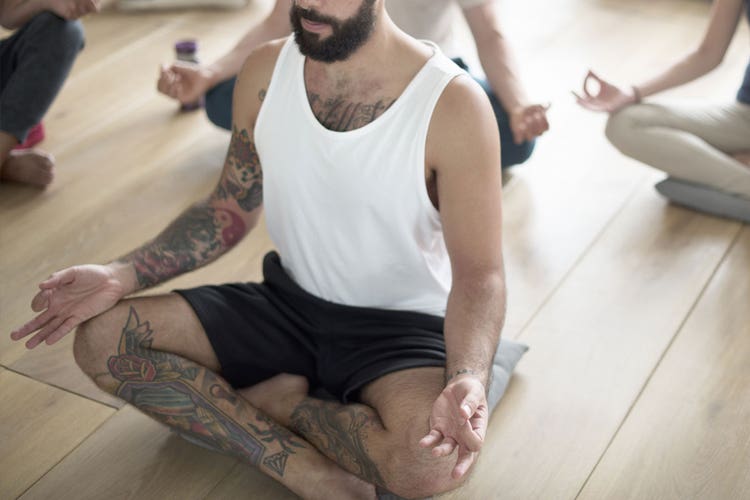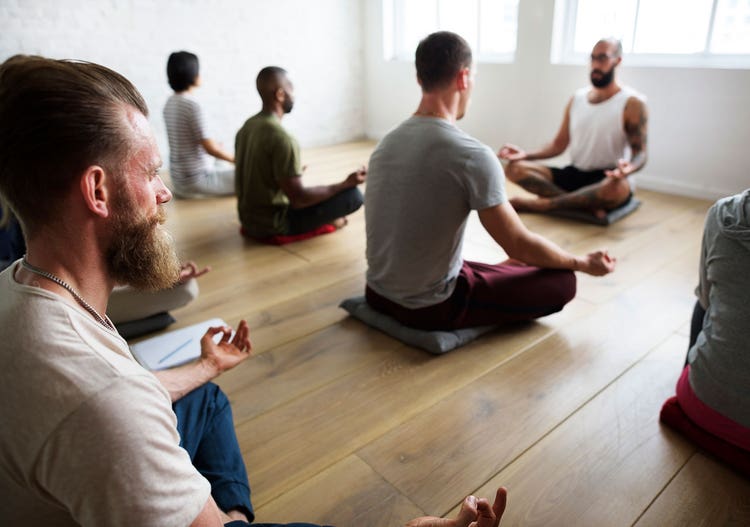Four Reasons to Meet Up to Meditate

A group gets you benefits that solo practice might not.
Having meditated on and off for more than a decade, I’ve taken many meditation workshops, classes and courses. It took me years to develop a consistent home practice, and there are still mornings I find myself resistant to taking my seat. But now I know two things: I can do it, and I feel better on the days that I do.
However, nothing compares to meditating in a group. The collective energy (a culmination of concerted group concentration) is palpable and powerful, drawing you deeper below the surface of the mind’s constant chatter. While you might be inclined to think a group environment would be more distracting, meditating with others has the opposite effect—it’s actually easier!
I can sit in meditation for much longer periods, and my experiences tend to be twice as profound when I’m surrounded by others with the same intention. I even have an easier time staying in meditation during global meditations when I know a large number of people all over the world are meditating simultaneously “with” me.
There truly is something inexplicably magical about collective meditation, and if you’re new/newer to the practice, it’s definitely the place to begin, become comfortable and gain confidence before striking out on your own at home. Or if you’ve been meditating solo for a while, it may be time to get out and rejoin a community of like-minded individuals. From the accountability aspect to the profound effects of collective group energy, there are many benefits associated with group meditation.
Here are four convincing reasons to meet up to meditate:
Meditating with others helps develop discipline

One of the largest challenges to developing a meditation practice is the discipline it takes. It can be quite difficult to take time out of your busy day, and away from your busy mind, to sit and be still. At home, you have to force yourself to sit down, unplug and meditate. There’s always a million and one other things to attend to, and there’s hardly enough time as it is. Before you know it, you’ve missed your opportunity to take your seat and you’re already onto the next thing. The excuses are endless, and it’s easy to skip out on your meditation practice.
Committing to a meditation class, or participating in an intro course, holds you accountable, and carving out a set day and time to meditate during your hectic week makes it more manageable. It also makes it routine (which makes it a habit over time). You know at this time on this day you’re going to be at this place to meditate with these people. You no longer have to make the choice to sit down and meditate. All you have to do is show up, which is half the battle. The other half is staying seated once you do.
At home, by yourself, surrounded by everything that must be taken care of, it’s tempting (and too easy!) to bail part of the way through your meditation practice. The doorbell rings, the dog barks, the kids scream, you remember you forgot to email someone back, plus your phone is right there begging to be picked up. The distractions at home are endless, constantly pulling your focus everywhere. It takes extreme discipline to not give into the temptations of your mind. (I still end up petting my dogs if they come into the room during my home meditation practice.) Just knowing that you’re not beholden to stay in meditation and that you can quit at any moment can be wildly distracting.
Simply put: Getting up and doing something else isn’t really an option when you’re in group meditation (or you’re extremely less likely to). Not having the option to suddenly get up and check social media, fold the laundry or, say, feed the cat can be freeing for the mind, allowing you to focus for longer and longer periods—developing the discipline it takes to continue your meditation practice at home.
Group meditation comes with a support system

Did I mention that meditation isn’t easy? There’s the showing up and staying seated, the mental struggle to stay focused and physical discomfort of sitting still, plus the myriad of difficult emotions, feelings and memories that tend to arise while you’re meditating (particularly in the beginning). Like all personally challenging long-term endeavors, such as weight loss and marathon training, your chances for success increase with the help of a friend.
There’s an added element of support built in to group meditation. Not only is a teacher there to guide and support you throughout the entirety of your practice, but you’re also surrounded by others facing similar challenges; you’re not alone in the trenches, so to speak. In group meditation classes or workshops, there tends to be a range of experience level, from newbies to longtime meditators, and it can be encouraging and really helpful to hear other people share their personal challenges and experiences as well as insights. While their challenges may not be exactly the same as yours, simply recognizing that you’re not the only one struggling with certain things can relieve a large amount of anxiety when it comes to meditating. Besides, as you continue to meditate, chances are you’ll encounter similar experiences.
And you can always ask questions! The feedback provided in a group meditation setting is invaluable. Plus, if you have a question, most likely someone else in the room has the same question. And sometimes another person asks something and you get an answer to a question you didn’t even know you had.
Meditating with others cultivates a sense of belonging and connection

One of my favorite things about meditation groups is that you get to come exactly as you are; there are no cool kids in meditation class. And there is zero pressure to be anything other than how you are. Instead, there is a loving sense of acceptance and belonging unique to meditation gatherings that allows for true authenticity and meaningful interactions.
The truth is, most of us spend the majority of our time alone—in our cars, at our desks and on our phones—disconnected from those around us. Joining a meditation group is a great way to connect with like-minded individuals minus the pressure to impress. Everyone there is on their own inward journey, holding space for everyone else. There’s no “better than” or judgment of any kind.
There’s also a more profound sense of connection that manifests during collective meditation—a connection beyond words that doesn’t require sharing our personal stories. Rather than the usual extroverted social exchange we’re generally accustomed to, when you meditate with others, you share a very different kind of experience—gathered together in sacred space, experiencing the same silent, spacious stillness of meditation. The further you settle into being, you develop a deeper sense of connection to yourself as well as others and the world around.
Group intention is a powerful force

With everything disturbing that’s going on around the world, it’s easy to feel hopeless, alone and at a loss. If you’re at all sensitive or empathic, it can be downright debilitating at times. One of the best things to do is to surround yourself with like-minded people who are equally concerned with the current humanitarian and environmental crisis. You’ll just feel better speaking and being with people who understand the way you’re feeling and who are going through similar things.
Meditation groups tend to be a collection of more conscious individuals who are aware of the bigger picture. By joining, there’s a sense that you are a part of something larger than yourself and that your contribution (no matter how big or small) matters. More often than not, there’s a larger group intention—a shared intention for change, peace, healing, sending love out into the world, etc. And believe it or not, various studies have shown that a group of individuals collectively focused on the same beautiful intention has the potential to change the world beyond themselves.
Known as the Maharishi Effect, there have been nearly 50 separate research studies conducted (many of which have been published in the “Journal of Crime and Justice”) showing that group meditation can have far-reaching positive effects. The first study was conducted in 1978 when 7,000 people gathered to meditate collectively for three weeks. Upon reviewing the data, researchers discovered a correlation between meditation and the decline of negative events. Statistically, there were less suicides and car accidents during that period. Another study was conducted in Merseyside, England, from 1988 to 1991, during which a number that exceeded 1 percent of the total population meditated together every single day. The results showed that the crime rate steadily dropped, so much so that Merseyside went from the third highest crime rate to the lowest-ranked city in England over that period. And the studies go on and on.
As Margaret Mead once said, “Never doubt that a small group of people can change the world. Indeed, it is the only thing that ever has.”
Photography: Rawpixel Ltd, Thinkstock; gustavofrazao, Adobe Stock; demaerre, Thinkstock; luckybusiness, Adobe Stock; Rawpixel Ltd, Thinkstock